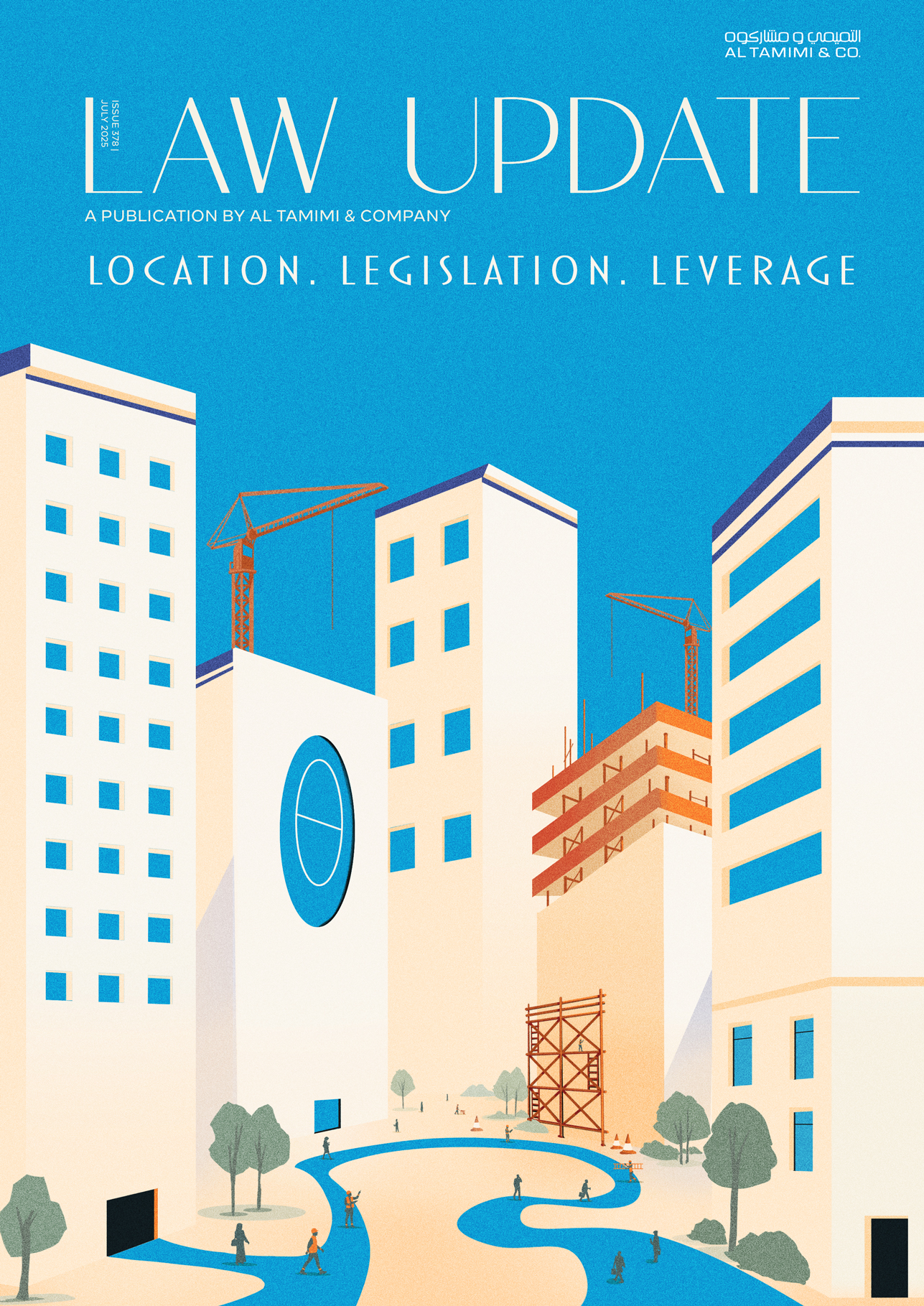- Arbitration
- Banking & Finance
- Capital Markets
- Commercial
- Competition
- Construction & Infrastructure
- Corporate / Mergers & Acquisitions
- Corporate Services
- Corporate Structuring
- Digital & Data
- Dispute Resolution
- Employment & Incentives
- Family Business & Private Wealth
- Innovation, Patents & Industrial Property (3IP)
- Insurance
Find a Lawyer
Book an appointment with us, or search the directory to find the right lawyer for you directly through the app.
Find out more
Real Estate & Construction and Hotels & Leisure
Real estate, construction, and hospitality are at the forefront of transformation across the Middle East – reshaping cities, driving investment, and demanding increasingly sophisticated legal frameworks.
In the June edition of Law Update, we take a closer look at the legal shifts influencing the sector – from Dubai’s new Real Estate Investment Funds Law and major reforms in Qatar, to Bahrain’s push toward digitalisation in property and timeshare regulation. We also explore practical issues around strata, zoning, joint ventures, and hotel management agreements that are critical to navigating today’s market.
As the landscape becomes more complex, understanding the legal dynamics behind these developments is key to making informed, strategic decisions.


2025 is set to be a game-changer for the MENA region, with legal and regulatory shifts from 2024 continuing to reshape its economic landscape. Saudi Arabia, the UAE, Egypt, Iraq, Qatar, and Bahrain are all implementing groundbreaking reforms in sustainable financing, investment laws, labor regulations, and dispute resolution. As the region positions itself for deeper global integration, businesses must adapt to a rapidly evolving legal environment.
Our Eyes on 2025 publication provides essential insights and practical guidance on the key legal updates shaping the year ahead—equipping you with the knowledge to stay ahead in this dynamic market.
The leading law firm in the Middle East & North Africa region.
A complete spectrum of legal services across jurisdictions in the Middle East & North Africa.
-
Practices
- All Practices
- Banking & Finance
- Capital Markets
- Commercial
- Competition
- Construction & Infrastructure
- Corporate / Mergers & Acquisitions
- Corporate Services
- Corporate Structuring
-
Sectors
-
Country Groups
-
Client Solutions
Today's news and tomorrow's trends from around the region.
17 offices across the Middle East & North Africa.
Our Services
 Back
Back
-
Practices
- All Practices
- Banking & Finance
- Capital Markets
- Commercial
- Competition
- Construction & Infrastructure
- Corporate / Mergers & Acquisitions
- Corporate Services
- Corporate Structuring
- Digital & Data
- Dispute Resolution
- Employment & Incentives
- Family Business & Private Wealth
- Innovation, Patents & Industrial Property (3IP)
- Insurance
- Intellectual Property
- Legislative Drafting
- Private Client Services
- Private Equity
- Private Notary
- Projects
- Real Estate
- Regulatory
- Tax
- Turnaround, Restructuring & Insolvency
- Compliance, Investigations and White-Collar Crime
-
Sectors
-
Country Groups
-
Client Solutions
- Law Firm
- /
- Insights
- /
- Law Update
- /
- September 2015
- /
- Electronic signatures in the UAE
Electronic signatures in the UAE
Sana Saleem - Associate - Digital & Data
September 2015
We have seen an increase in the number of enquiries from clients wanting use electronic signatures in their business processes in the UAE.
Some of the reasons for the limited adoption may be concerns about the following aspects:
- Does the law recognise an electronic signature as having legal force and effect?;
- What criteria should an electronic signature to meet in order to be enforceable?; and
- Is an electronic signature admissible as evidence in court in the event of a dispute between the parties to the agreement?
It is important to understand the legal framework in relation to the enforceability of electronic signatures before adopting electronic signatures for your business.
E-signatures in the UAE
In the UAE, the use and admissibility of electronic signatures is governed by Federal Law No.1 of 2006 regarding Electronic Transactions and E-Commerce (“Federal E-commerce Law”).
Basic electronic signatures are defined broadly to include all types of electronic signatures. These are generally defined as data in electronic form which are attached to or logically associated with other electronic data and which serve as a method of authentication.
An electronic signature that meets the requirements of the Federal E-commerce Law has legal force and effect under the Federal E-commerce Law. The Federal E-commerce Law further provides that nothing in the laws of evidence (which includes Federal Law No. 10 of 1992 (“Law of Evidence in Civil and Commercial Transactions”)) shall prevent the admission of an electronic message or e-signature in evidence.
Reliance on electronic signatures must be reasonable. Reasonableness is generally based on the following factors:
- the nature, value and importance of the transaction being supported by the electronic signature;
- steps taken by the relying party to verify the identity of the signatory of the electronic signature;
- evidence of prior breach or cancellation of the electronic signature;
- previous transactions between the parties, which relied on electronic signatures; and
- any other relevant factor.
There are, however, specific categories of transactions and documents for which electronic signatures may not be used, including:
- transactions and issues relating to personal law such as marriage, divorce and wills;
- deeds of title to immovable property;
- negotiable instruments;
- transactions involving the sale, purchase, lease (for a term of more than 10 years) and other disposition of immovable property and the registration of other rights relating to immovable property;
- any document legally required to be attested before a Notary Public, and
- any other documents or transactions exempted by special provision of the law.
Secure e-signatures
The Federal E-commerce Law also provides for a ‘secure’ electronic signature for which there is a legal presumption of reliability. This may be contrasted with ‘simple’ electronic signatures for which no such presumption exists in law. Secure electronic signatures must be issued by recognised service providers in order to qualify as secure electronic signatures under the law.
Conclusion
It is important to bear in mind that electronic signatures are only as secure as the business processes and technology used to create them. High value or more important transactions need better quality electronic signatures – signatures used for these transactions need to be more securely linked to the signatory in order to provide the level of assurance needed and to ensure trust in the underlying system.
Al Tamimi & Company’s Technology, Media & Telecommunications team regularly advises on e-signatures. For further information please contact Nick O’Connell (n.oconnell@tamimi.com) or Sana Saleem (s.saleem@tamimi.com)
Stay updated
To learn more about our services and get the latest legal insights from across the Middle East and North Africa region, click on the link below.


